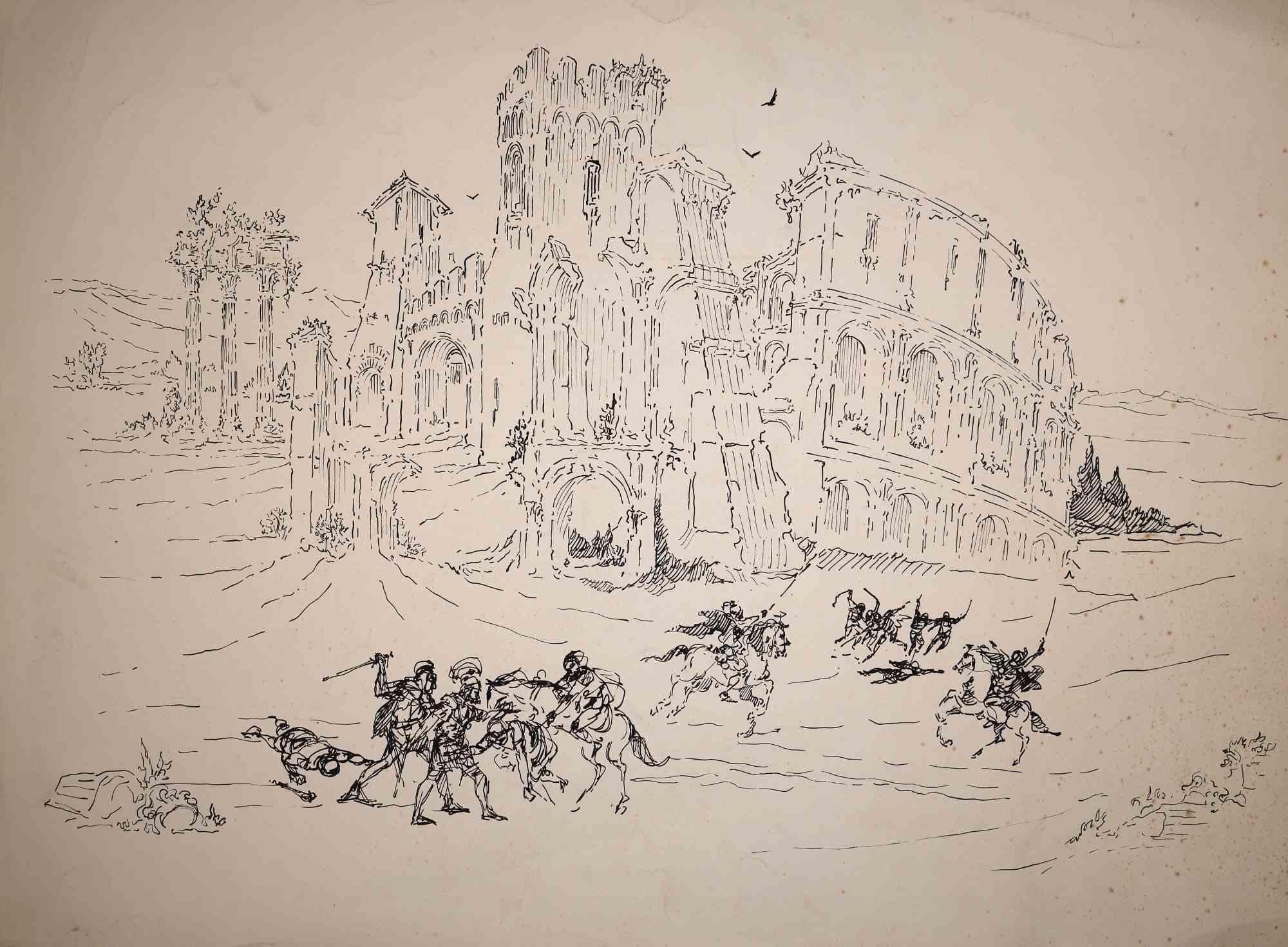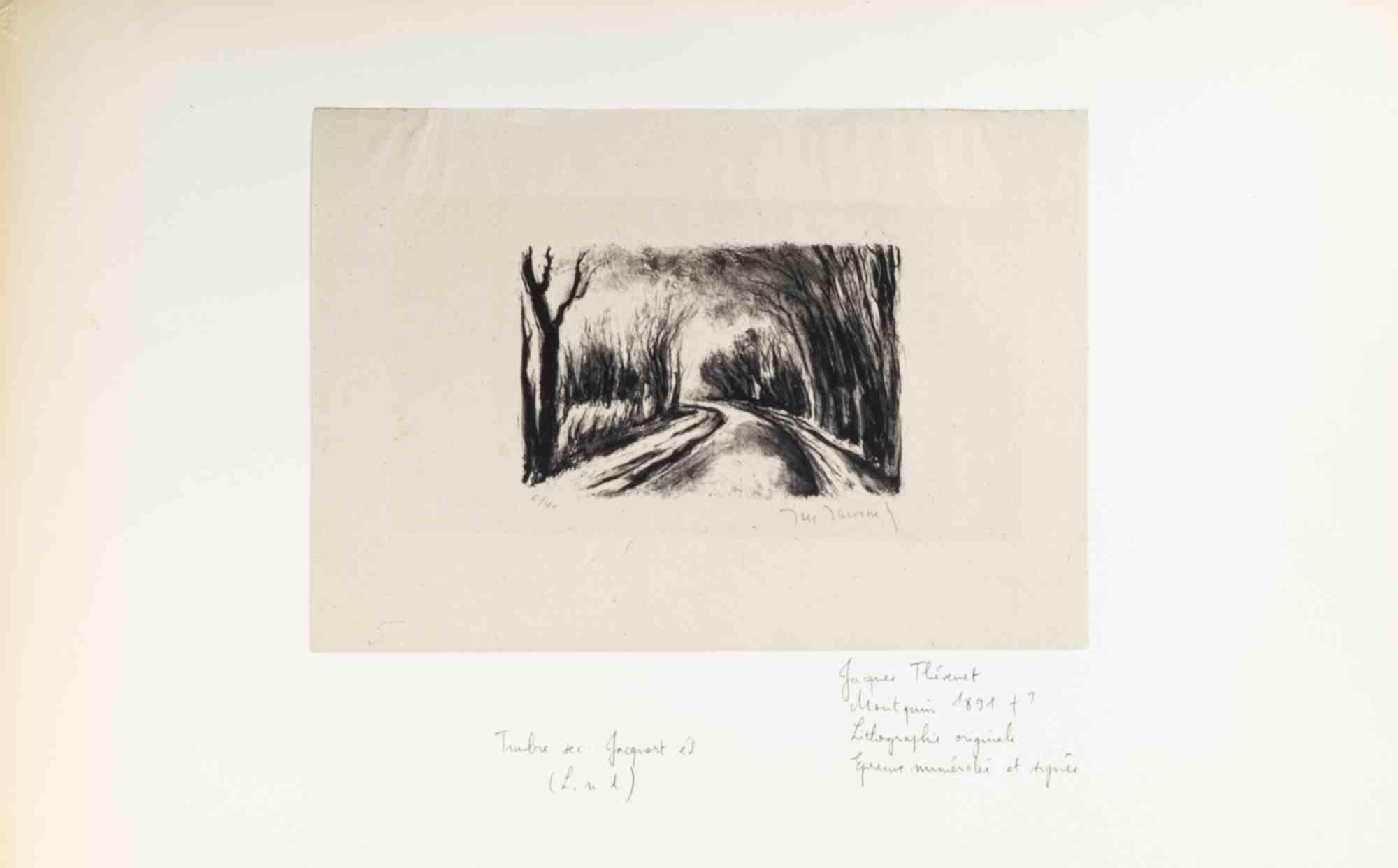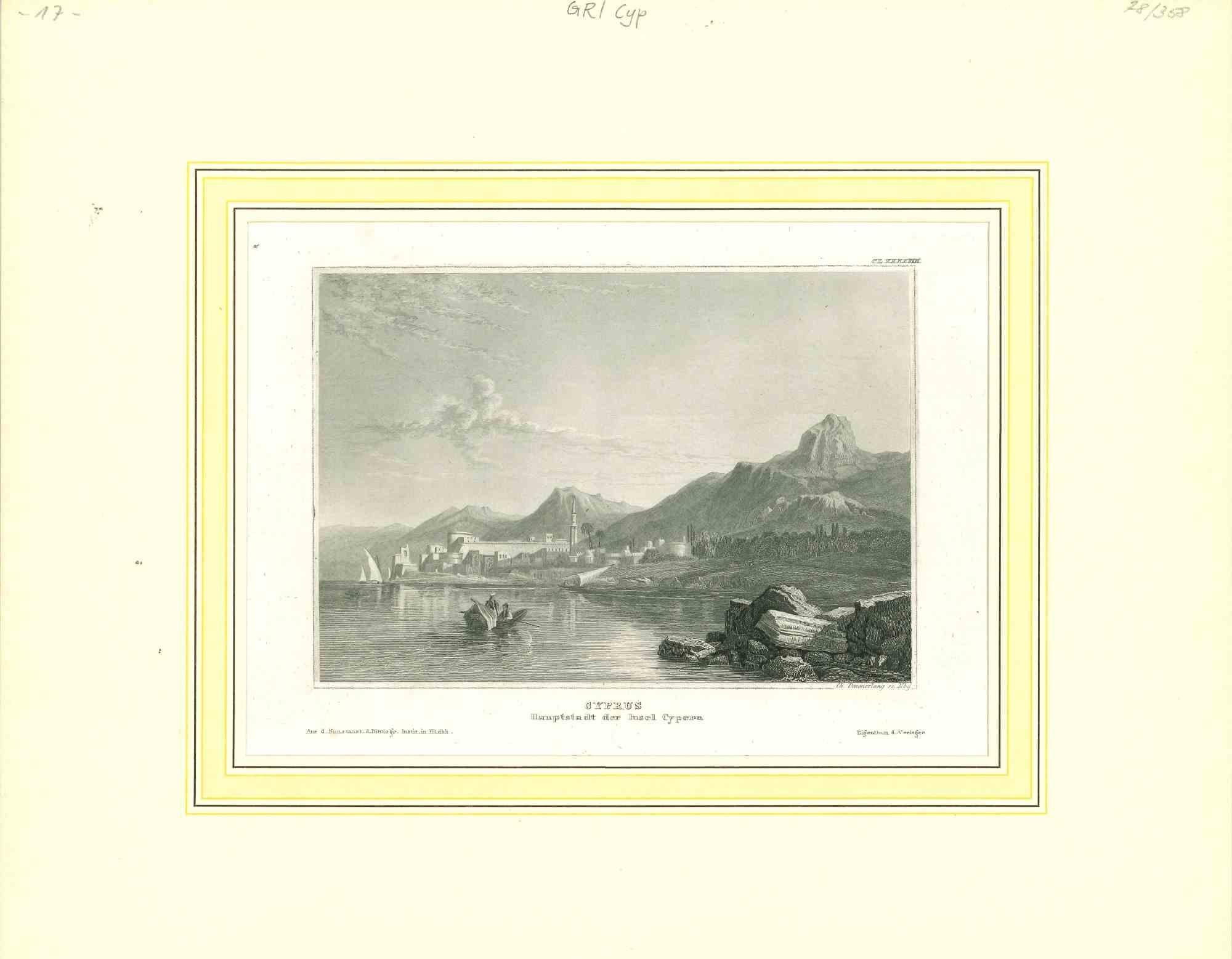Items Similar to Ancient View of Bern - Original Lithograph - Mid-19th Century
Want more images or videos?
Request additional images or videos from the seller
1 of 2
UnknownAncient View of Bern - Original Lithograph - Mid-19th CenturyMid-19th Century
Mid-19th Century
About the Item
Ancient View of Bern is an original modern artwork realized in the mid-19th Century.
Original B/W Lithograph on Ivory Paper.
Inscripted on the lower margin: Bern (Canton Bern). Engraved by T. Highman. Printed by Barlett.
Fair conditions. Some Foxing is present along the margins of the sheet.
Total Dimensions: 20.5 x 27 cm.
Bern is an excellent Modern Artwork; a delicate Lithograph depicting a beautiful view on a Typical Austrian Landscape.
- Creation Year:Mid-19th Century
- Dimensions:Height: 4.73 in (12 cm)Width: 6.89 in (17.5 cm)Depth: 0.04 in (1 mm)
- Medium:
- Period:
- Framing:Framing Options Available
- Condition:Insurance may be requested by customers as additional service, contact us for more information.
- Gallery Location:Roma, IT
- Reference Number:
About the Seller
4.9
Platinum Seller
These expertly vetted sellers are 1stDibs' most experienced sellers and are rated highest by our customers.
1stDibs seller since 2017
6,806 sales on 1stDibs
Typical response time: 3 hours
- ShippingRetrieving quote...Ships From: Monaco, Monaco
- Return PolicyA return for this item may be initiated within 14 days of delivery.
More From This SellerView All
- Roman Glimpses - Original Lithograph - Early 20th CenturyLocated in Roma, ITRoman Glimpses is an original artwork realized by an artist of the 20th Century. Good condition apart from some moisture spots present on the sheet.Category
Early 20th Century Modern Landscape Prints
MaterialsLithograph, Paper
- The Road With Trees - Lithograph by Jacques Thévenet - Early 20th CenturyBy Jacques ThévenetLocated in Roma, ITThe Road With Trees is a print realized by Jacques Thèvenet in the early 20th Century. Lithograph on paper. Hand-signed, Numbered, edition of 6/40 p...Category
Early 20th Century Modern Landscape Prints
MaterialsPaper, Lithograph
- Reims The Cathedral in Flames - Original Lithographby Charles Jouas - 1914Located in Roma, ITReims The Cathedral in Flames is a Lithograph realized by Charles jouas in 1914. Good condition on a yellowed paper. Titled and dated on the upper margin, Editor and gallery on the...Category
1910s Modern Figurative Prints
MaterialsLithograph, Paper
- Ancient View of Cyprus - Lithograph - Mid-19th CenturyLocated in Roma, ITAncient View of Cyprus is an original modern artwork realized in the mid-19th Century. Original B/W Lithograph on Ivory Paper. Inscripted on the lower margin in Capital Letters: ...Category
Early 19th Century Figurative Prints
MaterialsLithograph, Paper
- Ancient View of Corfu - Lithograph - Mid-19th CenturyLocated in Roma, ITAncient View of Corfu is an original modern artwork realized in the mid-19th Century. Original B/W Lithograph on Ivory Paper. Inscripted on the lower margin in Capital Letters: C...Category
Mid-19th Century Modern Figurative Prints
MaterialsLithograph, Paper
- Ancient View of the Piraeus - Lithograph - Mid-19th CenturyLocated in Roma, ITAncient View of the Piraeus is an original modern artwork realized in the mid-19th Century. Original B/W Lithograph on Ivory Paper. Inscripted ...Category
Early 19th Century Modern Figurative Prints
MaterialsLithograph, Paper
You May Also Like
- Toulouse Lautrec Original Lithograph Famous Political 1800s Collection SignedBy Henri de Toulouse-LautrecLocated in Milwaukee, WI"Lautrec Book: From Au Pied du Sinai written by Georges Clemenceau" lithographs created by the legendary Henri de Toulouse-Lautrec. This book, Au Pied...Category
1890s Post-Impressionist Figurative Prints
MaterialsLithograph, Mulberry Paper
- "The Drive" - Figurative Golfing LandscapeBy Douglas AdamsLocated in Soquel, CA20th century lithograph copy of an original painting by British artist Douglas Adams (English, 1853-1920). Signature in the print. Copy under the im...Category
1970s Realist Landscape Prints
MaterialsLithograph, Laid Paper
- House at Gregory Point (Colorado), 1930s Black and White Landscape LithographBy Arnold RönnebeckLocated in Denver, COOriginal Arnold Ronnebeck (1885-1947) lithograph of a home in Gregory Point, near Central City, Colorado from the 1930s. Edition of 25 printed. Presented in a custom frame, outer dimensions measure 23 ¼ x 18 ½ inches. Image size is 19 ¼ x 13 ¼ inches Print is clean and in very good vintage condition - please contact us for a detailed condition report. Provenance: Estate of Arnold Ronnebeck Expedited and international shipping is available - please contact us for a quote. About the Artist: Modernist sculptor, lithographer and museum administrator, Rönnebeck was a noted member of European and American avant-garde circles in the early twentieth century before settling in Denver, Colorado, in 1926. After studying architecture at the Royal Art School in Berlin for two years beginning in 1905, he moved to Paris in 1908 to study sculpture with Aristide Maillol and Émile-Antoine Bourdelle. While there he met and befriended American modernist painter, Marsden Hartley, of whom he sculpted a bronze head that was exhibited at the Salon d’Automne in Paris in 1912 and the following year at Hartley’s solo show of paintings at Alfred Stieglitz’s Gallery 291 in New York. A frequent guest of Gertrude Stein’s Saturday "evenings" in Paris, she described Rönnebeck as "charming and always invited to dinner," along with Pablo Picasso, Mabel Dodge (Luhan) and Charles Demuth. After the outbreak of World War I in 1914, Rönnebeck returned to Germany where he served as an officer in the German Imperial Army on the front lines. Twice wounded, including in the Battle of Marne in France, Kaiser Wilhelm II awarded him the Iron Cross. During the war Hartley fell in love with Rönnebeck’s cousin, Lieutenant Karl von Freyburg, who was killed in combat. As a tribute to Freyburg, Hartley created Portrait of a German Officer (1914) now in the Metropolitan Museum of Art in New York. After the war Rönnebeck traveled in Italy with German writer, Max Sidow, and German poet, Theodor Daubler, doing a series of drawings of Positano and the Amalfi Coast that formed the basis for his lithographs on the subject. The death of his finacée, the young American opera singer Alice Miriam in 1922 and his own family’s increasing financial problems in post-World War I Germany led him to immigrate to the United States in 1923. After living briefly with Miriam’s family in Washington, DC, he moved to New York where he became part of the avant-garde circle around Alfred Stieglitz. His essay, "Through the Eyes of a European Sculptor," appeared in the catalog for the Anderson Gallery exhibition, "Alfred Stieglitz Presents Seven Americans: 159 Paintings, Photographs & Things, Recent & Never Publicly Shown, by Arthur G. Dove, Marsden Hartley, John Marin, Charles Demuth, Paul Strand, Georgia O’Keeffe, Alfred Stieglitz." In New York Rönnebeck began producing Precisionist-style lithographs of the city’s urban landscapes which he termed "living cubism." Some of them were reproduced in Vanity Fair magazine. Through Stieglitz he met Erhard Weyhe head of the Weyhe Gallery who, with its director Carl Zigrosser, arranged Rönnebeck’s first solo American exhibition in May 1925 at the gallery in New York. Comprising some sixty works – prints, drawings and sculpture – the show subsequently traveled on a thirteen-month tour of major American cities. Until the end of his life, the gallery represented him, along with other American artists Adolf Dehn, Wanda Gag, Rockwell Kent, J.J. Lankes, Louis Lozowick, Reginald Marsh and John Sloan. In the summer of 1925, as the guest of Mabel Dodge Luhan, Rönnebeck first saw Taos, New Mexico, which Marsden Hartley had encouraged him to visit. It was there that he met his future wife, Louise Emerson, an easel painter and muralist. A year later they were married in New York before relocating to Denver. He served as director of the Denver Art Museum from 1926 to 1930 where he invited Marsden Hartley to lecture on Cézanne’s art in 1928. Rönnebeck fostered the development of the museum’s collection of American Indian art and the curation of modernist art exhibitions. In addition to his work at the museum, he was professor of sculpture at the University of Denver’s College of Fine and Applied Arts from 1929 to 1935, and wrote a weekly art column in the Rocky Mountain News. His best known Denver sculptures from the late 1920s in bronze, copper, stone, wood and terra cotta include a reredos, The Epiphany, at St. Martin’s Chapel; The History of Money (six panels) at the Denver National Bank; The Ascension at the Church of Ascension; and the William V. Hodges Family Memorial at Fairmount Cemetery. At the same time he did a series of terra cotta relief panels for La Fonda Hotel in Santa Fe, New Mexico. In the 1930s his bas-relief aluminum friezes of stylized Pueblo and Hopi Indian Kachina masks...Category
1930s American Modern Landscape Prints
MaterialsPaper, Lithograph
- Colorado Gold Dredge, Breckenridge, Signed Black and White Mining LithographBy Arnold RönnebeckLocated in Denver, COLithograph on paper titled 'Colorado Gold Dredge, Breckenridge' by Arnold Ronnebeck (1885-1947) from 1932. Numbered 15/25. Depicted is a gold dredge in Colorado mining town Breckenridge with a mountain landscape in the background. Presented in a custom frame measuring 17 ¼ x 21 ¼ inches. Image size measures 10 ¼ x 14 ¼ inches. Print is clean and in very good vintage condition - please contact us for a detailed condition report. Provenance: Estate of Arnold Ronnebeck Expedited and international shipping is available - please contact us for a quote. About the Artist: Modernist sculptor, lithographer and museum administrator, Rönnebeck was a noted member of European and American avant-garde circles in the early twentieth century before settling in Denver, Colorado, in 1926. After studying architecture at the Royal Art School in Berlin for two years beginning in 1905, he moved to Paris in 1908 to study sculpture with Aristide Maillol and Émile-Antoine Bourdelle. While there he met and befriended American modernist painter, Marsden Hartley, of whom he sculpted a bronze head that was exhibited at the Salon d’Automne in Paris in 1912 and the following year at Hartley’s solo show of paintings at Alfred Stieglitz’s Gallery 291 in New York. A frequent guest of Gertrude Stein’s Saturday "evenings" in Paris, she described Rönnebeck as "charming and always invited to dinner," along with Pablo Picasso, Mabel Dodge (Luhan) and Charles Demuth. After the outbreak of World War I in 1914, Rönnebeck returned to Germany where he served as an officer in the German Imperial Army on the front lines. Twice wounded, including in the Battle of Marne in France, Kaiser Wilhelm II awarded him the Iron Cross. During the war Hartley fell in love with Rönnebeck’s cousin, Lieutenant Karl von Freyburg, who was killed in combat. As a tribute to Freyburg, Hartley created Portrait of a German Officer (1914) now in the Metropolitan Museum of Art in New York. After the war Rönnebeck traveled in Italy with German writer, Max Sidow, and German poet, Theodor Daubler, doing a series of drawings of Positano and the Amalfi Coast that formed the basis for his lithographs on the subject. The death of his finacée, the young American opera singer Alice Miriam in 1922 and his own family’s increasing financial problems in post-World War I Germany led him to immigrate to the United States in 1923. After living briefly with Miriam’s family in Washington, DC, he moved to New York where he became part of the avant-garde circle around Alfred Stieglitz. His essay, "Through the Eyes of a European Sculptor," appeared in the catalog for the Anderson Gallery exhibition, "Alfred Stieglitz Presents Seven Americans: 159 Paintings, Photographs & Things, Recent & Never Publicly Shown, by Arthur G. Dove, Marsden Hartley, John Marin, Charles Demuth, Paul Strand, Georgia O’Keeffe, Alfred Stieglitz." In New York Rönnebeck began producing Precisionist-style lithographs of the city’s urban landscapes which he termed "living cubism." Some of them were reproduced in Vanity Fair magazine. Through Stieglitz he met Erhard Weyhe head of the Weyhe Gallery who, with its director Carl Zigrosser, arranged Rönnebeck’s first solo American exhibition in May 1925 at the gallery in New York. Comprising some sixty works – prints, drawings and sculpture – the show subsequently traveled on a thirteen-month tour of major American cities. Until the end of his life, the gallery represented him, along with other American artists Adolf Dehn, Wanda Gag, Rockwell Kent, J.J. Lankes, Louis Lozowick, Reginald Marsh and John Sloan. In the summer of 1925, as the guest of Mabel Dodge Luhan, Rönnebeck first saw Taos, New Mexico, which Marsden Hartley had encouraged him to visit. It was there that he met his future wife, Louise Emerson, an easel painter and muralist. A year later they were married in New York before relocating to Denver. He served as director of the Denver Art Museum from 1926 to 1930 where he invited Marsden Hartley to lecture on Cézanne’s art in 1928. Rönnebeck fostered the development of the museum’s collection of American Indian art and the curation of modernist art exhibitions. In addition to his work at the museum, he was professor of sculpture at the University of Denver’s College of Fine and Applied Arts from 1929 to 1935, and wrote a weekly art column in the Rocky Mountain News. His best known Denver sculptures from the late 1920s in bronze, copper, stone, wood and terra cotta include a reredos, The Epiphany, at St. Martin’s Chapel; The History of Money (six panels) at the Denver National Bank; The Ascension at the Church of Ascension; and the William V. Hodges Family Memorial at Fairmount Cemetery. At the same time he did a series of terra cotta relief panels for La Fonda Hotel in Santa Fe, New Mexico. In the 1930s his bas-relief aluminum friezes of stylized Pueblo and Hopi Indian Kachina masks...Category
1930s American Modern Landscape Prints
MaterialsLithograph, Paper
- HARDWOOD TRAILLocated in Aventura, FLLithograph on paper. Hand signed, titled and numbered by the artist. Edition of 350. Artwork is in excellent condition. Certificate of Authenticity is included. All reasonable offers will be considered. About the artist: As a self taught artist, Jake's style has developed over many years, evolving since childhood. Early in life he nurtured a bond with nature and wildlife that eventually became the basis for his artistic endeavors. Jake captures the landscape with striking compositions emphasizing light and color. Among the artist\'s favorite subjects are serene lakes, forests, and mountains of North America. Jake has enjoyed a popular following throughout the past 23 years that he has been showing, and his art continues to attract collectors throughout Canada and beyond. His art has found homes...Category
1990s Realist Figurative Prints
MaterialsLithograph, Paper
- BLESSING OF THE HOUSE (JUDAICA ART)By Amram EbgiLocated in Aventura, FLLithograph with foil stamping on paper. Hand signed and numbered by the artist. From the edition of 350. Artwork is in excellent condition. Certificate of authenticity included. A...Category
Late 20th Century Contemporary Figurative Prints
MaterialsFoil
Recently Viewed
View AllMore Ways To Browse
Ancient Vintage
Views Of Canton
Woodblock Triptych
19th Century Academic Painting Man
Andre Heller
Andy Warhol The Velvet Underground
Andy Warhol Velvet Underground
Antique Collie
Antique Lithograph Portrait
Beauty And The Beast Poster Vintage
Beauty And The Beast Vintage Poster
Best Movie Posters
Black And White Fruit Bowl
Bullfight Art Print
Cat Clay Sculpture
Chagall Ballet
Charles Meyers
Coco Chanel Design





